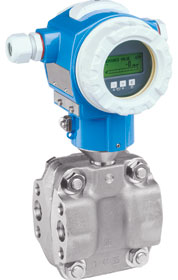

High-precision measuring technology saves energy and improves the quality of oxy-fuel combustion in glass furnaces.
In glass production, firing with pure oxygen aims to reduce nitrogen oxide NOx, improve glass quality and reduce the energy required. Europe has been converting to oxy-fuel combustion more and more in recent times, due to the lower volumes of waste gas, particle emission is considerably reduced. But there is a flip-side: the process places far higher demands on control engineering and measuring equipment.
Proven concept
From a process perspective, the regulation of oxygen with a purity rate of between 93% and 98% is a complex task and places strict demands on the measurement and control technology deployed. The volume flow of oxygen is conventionally measured using an orifice plate and in-line differential pressure measurement, such as with the Deltabar S PMD70 from Endress+Hauser. As the volume flow is one of the main parameters for control, the device must deliver highly accurate and reproducible measurements.
The pressure measuring devices have been approved for SIL2 functional safety according to IEC 61508, have a standard turn down of 100:1 and are equipped with a range of software functions that allow the unit to be optimally adjusted to suit each individual gas flow application. The measuring concept with an orifice plate and a differential pressure measuring device has stood the test of time in various plants all over the world.
Trouble-free measurement
The principle does have the disadvantage that it primarily measures the volumetric flow. The combustion processes, however, require a much more accurate mass flow measurement for thermal calculation.
In the case of liquid fuels, Coriolis has been the established principle to control the burner and record the actual mass flow. Now, thanks to the rapid technological advances this measuring technique has experienced in recent years, Coriolis instruments can easily be used to measure gaseous media without problems. Various versions of the measuring devices are available from Endress+Hauser, ranging from the compact NGmass to instruments for large nominal diameters and even two-wire devices. The high repeatability of 0,1% FS coupled with a high operable flow range, are ideal for this type of measurement task.
The information supplied by the measuring sensors is processed directly by the control system and then forwarded downstream for control purposes. Control valves implement changes without delay. This ensures the system can be optimally adjusted to the throughput rate and the power requirements of the glass furnace. A well tuned temperature profile can be implemented at any time for an optimum smelting process. Quick, high-precision and reliable measurement combined with an inter-coordinated control system guarantee high quality glass. The measuring concept is particularly advantageous if implemented in new systems, or to increase the performance of existing ones, as the absence of regenerators will keep investment costs down. Furthermore, the low volume flow allows for a smaller waste gas system, which can be designed at a far lower cost.
For more information contact Natlee Chetty, Endress+Hauser, +27 (0)11 262 8000, [email protected], www.za.endress.com
| Tel: | +27 11 262 8000 |
| Email: | [email protected] |
| www: | www.endress.com |
| Articles: | More information and articles about Endress+Hauser South Africa |

© Technews Publishing (Pty) Ltd | All Rights Reserved